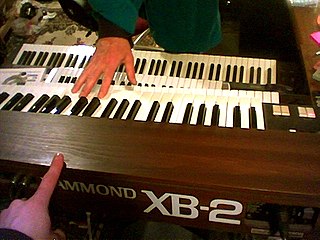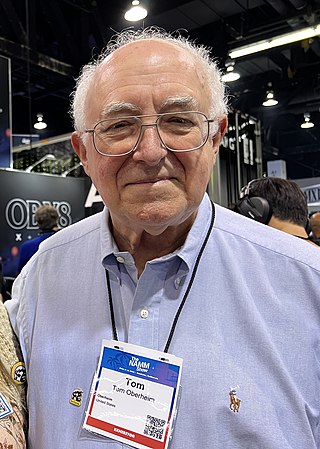
An electronic musical instrument or electrophone is a musical instrument that produces sound using electronic circuitry. Such an instrument sounds by outputting an electrical, electronic or digital audio signal that ultimately is plugged into a power amplifier which drives a loudspeaker, creating the sound heard by the performer and listener.

An effects unit, effects processor, or effects pedal is an electronic device that alters the sound of a musical instrument or other audio source through audio signal processing.

MIDI is a technical standard that describes a communication protocol, digital interface, and electrical connectors that connect a wide variety of electronic musical instruments, computers, and related audio devices for playing, editing, and recording music.

Roald Dahl was a British author of popular children's literature and short stories, a poet, screenwriter and a wartime fighter ace. His books have sold more than 300 million copies worldwide. Dahl has been called "one of the greatest storytellers for children of the 20th century".

Digital music technology encompasses digital instruments, computers, electronic effects units, software, or digital audio equipment by a performer, composer, sound engineer, DJ, or record producer to produce, perform or record music. The term refers to electronic devices, instruments, computer hardware, and software used in performance, playback, recording, composition, mixing, analysis, and editing of music.
A music sequencer is a device or application software that can record, edit, or play back music, by handling note and performance information in several forms, typically CV/Gate, MIDI, or Open Sound Control, and possibly audio and automation data for digital audio workstations (DAWs) and plug-ins.

A sampler is an electronic musical instrument that records and plays back samples. Samples may comprise elements such as rhythm, melody, speech, sound effects or longer portions of music.

Brent Mydland was an American keyboardist and singer. He was a member of the rock band The Grateful Dead from 1979 to 1990, a longer tenure than any other keyboardist in the band.
Keytar is a keyboard instrument similar to a synthesizer or MIDI controller that is supported by a strap around the neck and shoulders, similar to the way a guitar is held.

A pedalboard is a keyboard played with the feet that is usually used to produce the low-pitched bass line of a piece of music. A pedalboard has long, narrow lever-style keys laid out in the same semitone scalar pattern as a manual keyboard, with longer keys for C, D, E, F, G, A, and B, and shorter, raised keys for C♯, D♯, F♯, G♯ and A♯. Training in pedal technique is part of standard organ pedagogy in church music and art music.
SoundFont is a brand name that collectively refers to a file format and associated technology that uses sample-based synthesis to play MIDI files. It was first used on the Sound Blaster AWE32 sound card for its General MIDI support.

A MIDI controller is any hardware or software that generates and transmits Musical Instrument Digital Interface (MIDI) data to MIDI-enabled devices, typically to trigger sounds and control parameters of an electronic music performance. They most often use a musical keyboard to send data about the pitch of notes to play, although a MIDI controller may trigger lighting and other effects. A wind controller has a sensor that converts breath pressure to volume information and lip pressure to control pitch. Controllers for percussion and stringed instruments exist, as well as specialized and experimental devices. Some MIDI controllers are used in association with specific digital audio workstation software. The original MIDI specification has been extended to include a greater range of control features.

A one-man band is a musician who plays a number of instruments simultaneously using their hands, feet, limbs, and various mechanical or electronic contraptions. One-man bands also often sing while they perform.

A clonewheel organ is an electronic musical instrument that emulates the sound of the electromechanical tonewheel-based organs formerly manufactured by Hammond from the 1930s to the 1970s. Clonewheel organs generate sounds using solid-state circuitry or computer chips, rather than with heavy mechanical tonewheels, making clonewheel organs much lighter-weight and smaller than vintage Hammonds, and easier to transport to live performances and recording sessions.

A wind controller, sometimes referred to as a wind synthesizer, is an electronic wind instrument. It is usually a MIDI controller associated with one or more music synthesizers. Wind controllers are most commonly played and fingered like a woodwind instrument, usually the saxophone, with the next most common being brass fingering, particularly the trumpet. Models have been produced that play and finger like other acoustic instruments such as the recorder or the tin whistle. The most common form of wind controller uses electronic sensors to convert fingering, breath pressure, bite pressure, finger pressure, and other gesture or action information into control signals that affect musical sounds. The control signals or MIDI messages generated by the wind controller are used to control internal or external devices such as analog synthesizers or MIDI-compatible synthesizers, synth modules, softsynths, sequencers, or even non-instruments such as lighting systems.

Thomas Elroy Oberheim, known as Tom Oberheim, is an American audio engineer and electronics engineer best known for designing effects processors, analog synthesizers, sequencers, and drum machines. He has been the founder of four audio electronics companies, most notably Oberheim Electronics. He was also a key figure in the development and adoption of the MIDI standard. He is also a trained physicist.

A synthesizer is an electronic musical instrument that generates audio signals. Synthesizers typically create sounds by generating waveforms through methods including subtractive synthesis, additive synthesis and frequency modulation synthesis. These sounds may be altered by components such as filters, which cut or boost frequencies; envelopes, which control articulation, or how notes begin and end; and low-frequency oscillators, which modulate parameters such as pitch, volume, or filter characteristics affecting timbre. Synthesizers are typically played with keyboards or controlled by sequencers, software or other instruments and may be synchronized to other equipment via MIDI.
Julian Colbeck is an English businessman, musician and journalist. He is CEO of the multi-media music company Keyfax NewMedia and partner with Alan Parsons in "Alan Parsons' The Art & Science of Sound Recording". Formerly a professional keyboard player for over 25 years, Colbeck is also the author of numerous music-related books, the creator of Twiddly.Bits MIDI loops, the concept designer for the PhatBoy MIDI controller, and producer of many music technology videos and websites.

This is a glossary of jazz and popular music terms that are likely to be encountered in printed popular music songbooks, fake books and vocal scores, big band scores, jazz, and rock concert reviews, and album liner notes. This glossary includes terms for musical instruments, playing or singing techniques, amplifiers, effects units, sound reinforcement equipment, and recording gear and techniques which are widely used in jazz and popular music. Most of the terms are in English, but in some cases, terms from other languages are encountered.
The Samchillian Tip Tip Tip Cheeepeeeee is a type of electronic keyboard instrument invented by Leon Gruenbaum, that uses keys to trigger melodic intervals aka changes of pitch rather than the traditional fixed pitches.















